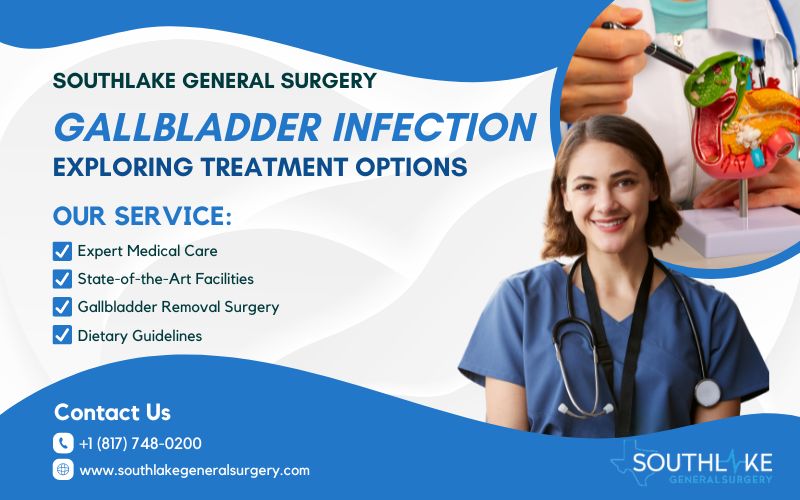Gallbladder infection, also known as cholecystitis, is a condition characterized by inflammation in the gallbladder. One of the small organs in the body, the gallbladder is shaped like a pear and can be found in the upper right quadrant of the abdomen, directly below the liver.
Its main function is to store and distribute bile, a digestive juice produced by the liver. When a gallstone blocks the bile duct, bile can back up into the gallbladder, leading to swelling, pain, and other complications.
Cholecystitis can be either acute, which happens quickly, or chronic, which lasts for a longer time. Cholecystitis is typically caused by gallstones. These are solid formations that develop in the gallbladder and can obstruct the flow of bile.
Additional reasons include gallbladder sludge, tumors, decreased blood flow to the gallbladder, and bacterial infections.
In this blog, we will discuss the symptoms, causes, diagnostic procedures, treatment options, and preventive measures for gallbladder infections. It is important to seek medical attention if you experience severe abdominal pain or recurrent gallbladder issues.
Early detection and proper management can help prevent complications and improve prognosis.
Key Highlights
- Cholecystitis is inflammation in the gallbladder, often caused by gallstones blocking the bile ducts.
- Common symptoms of cholecystitis include upper abdominal pain, nausea, vomiting, and fever. Diagnostic procedures for cholecystitis include blood tests, ultrasound, CT scan, and HIDA scan.
- Treatment options for cholecystitis include non-surgical treatments and gallbladder removal surgery.
- After gallbladder surgery, individuals may need to make diet and lifestyle adjustments for long-term care.
- Preventive measures for gallbladder infections include dietary measures and regular health check-ups.
- It is important to seek medical attention for severe abdominal pain or recurrent gallbladder issues.
What is a Gallbladder Infection?
A gallbladder infection, also known as cholecystitis, refers to inflammation in the gallbladder. The primary role of this organ is to accumulate and concentrate bile, a digestive fluid produced by the liver. Understanding the role of bile in the breakdown and digestion of fats is crucial.
When a gallstone or any other factor obstructs the flow of bile from the gallbladder, it can cause bile to back up and accumulate in the gallbladder. These factors can potentially lead to irritation, swelling, and inflammation in the gallbladder, which can result in cholecystitis.
Cholecystitis can be acute or chronic. Acute cholecystitis is a sudden and urgent form of inflammation, often caused by gallstones blocking the cystic duct, which is the tube that connects the gallbladder to the bile duct.
Chronic cholecystitis is a long-term condition characterized by recurrent episodes of inflammation. It is usually associated with the presence of gallstones and ongoing inflammation in the gallbladder.
There are two types of gallbladder inflammation: one is caused by gallstones (calculous), while the other is not related to gallstones (acalculous).
If left untreated, cholecystitis can lead to complications such as infection, tissue death, and perforation of the gallbladder. It is important to seek medical attention for timely diagnosis and treatment.
Common Causes of Gallbladder Infections
Gallbladder infections, known as cholecystitis, often result from gallstones blocking the bile ducts. Gallstones are solid masses of cholesterol or bile pigment, that develop in the gallbladder.
When these gallstones block the tubes that carry bile from the gallbladder, it can cause bile to accumulate and lead to inflammation.
Cholecystitis can also be caused by factors like bacterial infections in the bile duct system, pancreatic or liver tumors, decreased blood flow to the gallbladder, gallbladder sludge, and other conditions affecting bile ducts and flow.
These issues can disrupt normal gallbladder function, resulting in inflammation, pain, and cholecystitis symptoms. Identifying the root causes of gallbladder infections is crucial for selecting appropriate treatment and preventive strategies.
Recognizing the Symptoms of Cholecystitis
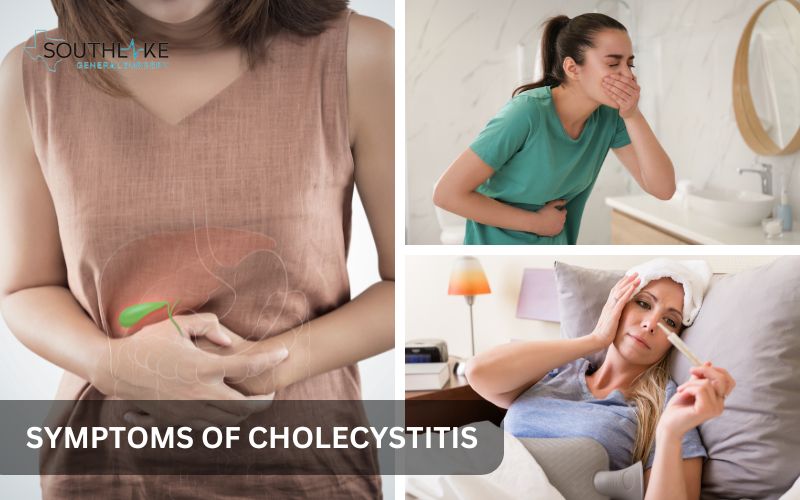
Recognizing the symptoms of cholecystitis is important for early detection and treatment. Common symptoms of acute cholecystitis include sudden, intense pain in the upper right part of the abdomen, which may radiate to the back or below the right shoulder blade. This pain is often accompanied by nausea, vomiting, and fever.
In some cases, the pain may be mistaken for chest pain or a heart attack. It is important to seek medical attention if you experience these symptoms, especially if they are severe or persistent.
Early Signs of Gallbladder Infection
Early signs of gallbladder infection, or cholecystitis, often manifest as abdominal pain. This pain is typically located in the upper right part of the abdomen and can be intense and sudden. The pain may also radiate to the back or below the right shoulder blade.
Other early symptoms of cholecystitis can include nausea, vomiting, and fever. These symptoms can be indicative of inflammation and infection in the gallbladder.
It is important to pay attention to these early signs and seek medical attention for proper diagnosis and treatment. Ignoring these symptoms can lead to complications and further damage to the gallbladder and surrounding organs.
When to Seek Medical Attention
If you experience severe abdominal pain, especially in the upper right part of the abdomen, it is important to seek immediate medical attention. Severe abdominal pain can be a sign of a serious condition, such as cholecystitis.
If the pain is persistent, accompanied by fever, nausea, vomiting, or other concerning symptoms, it may be necessary to go to the emergency room. For an accurate diagnosis and appropriate treatment, it is crucial to visit a doctor as soon as possible.
Your healthcare provider will be able to evaluate your symptoms, perform necessary tests, and provide appropriate medical advice and treatment options.
It is always better to err on the side of caution when it comes to your health and seek medical attention when you are experiencing severe or unusual symptoms.
Diagnostic Procedures
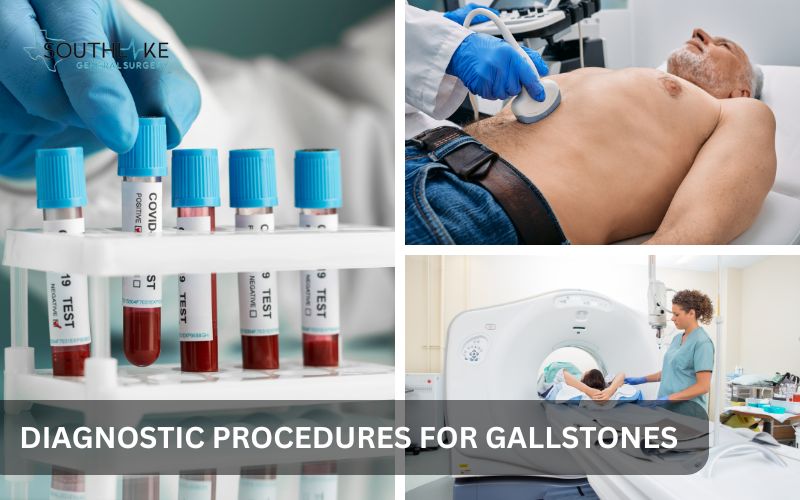
Diagnostic procedures are essential for detecting and diagnosing gallbladder infections. Common diagnostic methods for cholecystitis include laboratory tests, ultrasound, CT scans, and HIDA scans.
- Blood tests can detect inflammation and infection markers, while ultrasound produces. images of the gallbladder and nearby structures to reveal gallstones and inflammation.
- CT scan can show the gallbladder and its surrounding organs in detail.
- HIDA scans assess gallbladder function and bile flow using a radioactive tracer.
These procedures assist healthcare providers in identifying the cause and extent of cholecystitis to determine suitable treatment approaches.
Laboratory Tests and Their Importance
Laboratory tests, such as blood tests, play a crucial role in diagnosing gallbladder infections. Blood tests can help identify markers of inflammation and infection in the body, providing valuable information about the presence and severity of cholecystitis.
These tests can measure levels of white blood cells, C-reactive protein, and liver enzymes, which can indicate inflammation and infection in the gallbladder.
Additionally, your medical history and symptoms will be taken into consideration when interpreting the results of these tests.
Laboratory tests are an important component of the diagnostic process for cholecystitis, helping healthcare providers determine the appropriate treatment options and monitor the effectiveness of the treatment.
Imaging Techniques Used in Diagnosis
Imaging methods are vital in diagnosing gallbladder infections. Ultrasound, a common imaging technique, utilizes sound waves to generate images of the gallbladder and nearby structures. It can detect gallstones, signs of inflammation, and other irregularities.
HIDA scans, also known as hepatobiliary iminodiacetic acid scans, require a radioactive tracer injection to assess gallbladder function and bile flow. This scan reveals details about gallbladder structure, function, and the presence of blockages.
CT scans, or computed tomography scans, utilize X-rays and a computer to produce detailed images of the gallbladder, bile ducts, and adjacent organs. These imaging methods are crucial for diagnosing cholecystitis and selecting suitable treatment options.
Treatment Options Available
There are several treatment options available for gallbladder infections, depending on the severity and underlying cause of the condition.
Non-surgical treatments may be used to manage mild cases of cholecystitis. These can include antibiotics to treat infections, intravenous fluids to stay hydrated, and pain relief medication to alleviate symptoms.
However, in cases where the infection is severe or recurrent, gallbladder removal surgery, known as cholecystectomy, may be recommended. This surgical procedure involves removing the gallbladder, eliminating the source of infection, and preventing future episodes of cholecystitis.
Your healthcare provider will determine the most appropriate treatment option based on your individual case and medical history.
Non-Surgical Treatments and Their Effectiveness
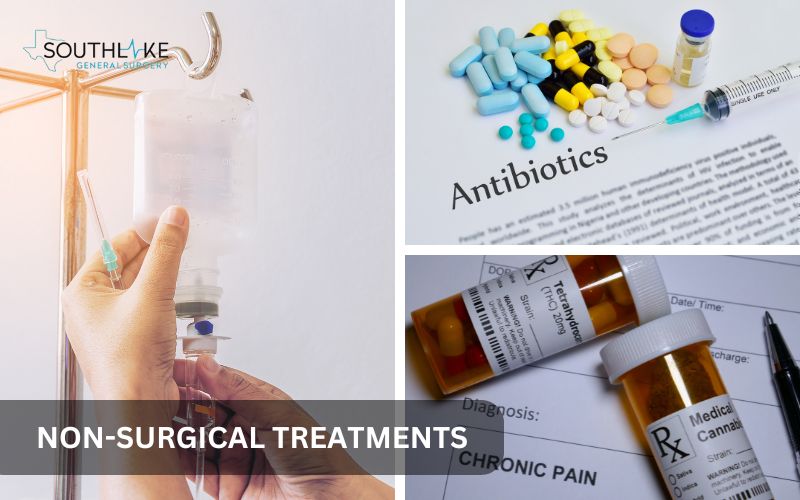
Non-surgical treatments can be effective in managing mild cases of gallbladder infections.
- Antibiotics may be prescribed to treat bacterial infections in the gallbladder and reduce inflammation.
- To ensure proper hydration and nutrition, intravenous fluids can be given.
- Pain relief medication can help alleviate the discomfort associated with cholecystitis, especially during episodes of biliary colic, which is characterized by sudden and intense pain in the upper abdomen.
These non-surgical treatments aim to relieve symptoms and prevent complications. However, it is important to note that non-surgical treatments may not be effective in treating severe or recurrent cases of cholecystitis.
In such cases, gallbladder removal surgery may be necessary to eliminate the source of infection and prevent future episodes.
Gallbladder Removal Surgery: When is it Necessary?
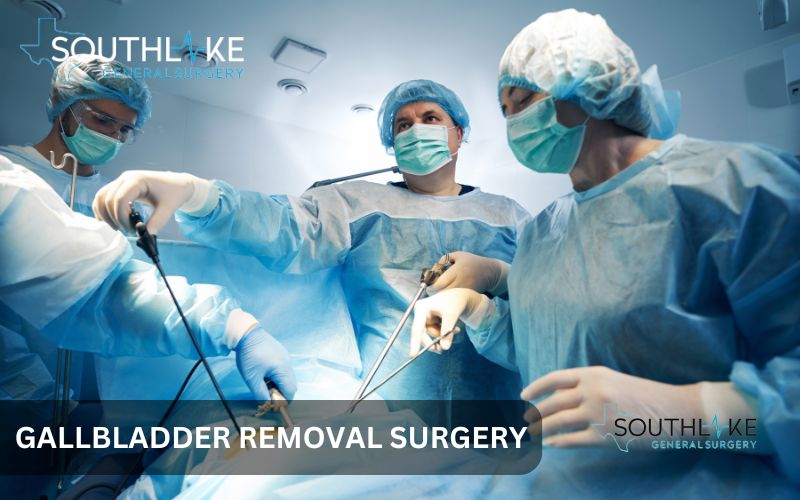
Gallbladder removal surgery, also known as cholecystectomy, may be necessary in cases of severe or recurrent gallbladder infections. This surgical procedure involves the removal of the gallbladder, eliminating the source of infection and preventing future episodes of cholecystitis.
The most common method of gallbladder removal is laparoscopic cholecystectomy, which involves making small incisions in the abdomen and using a flexible tube with a light and camera (endoscope) to guide the removal of the gallbladder.
In some cases, open surgery may be required if there are complications or if laparoscopic surgery is not feasible. A common surgical technique for preventing bile leakage is to clip or tie off the cystic duct, which is the tube that connects the gallbladder to the bile duct.
Many patients who undergo gallbladder removal surgery go on to lead normal, healthy lives after the procedure.
Life After Gallbladder Surgery
Life after gallbladder surgery, or cholecystectomy, involves adjustments to diet and lifestyle. While the gallbladder is responsible for storing and releasing bile to aid in digestion, the body can adapt to the absence of the gallbladder.
It is important to maintain a healthy life by consuming a balanced diet, avoiding fatty and greasy foods, and eating smaller, more frequent meals. Regular physical activity and maintaining a healthy weight are also important for overall well-being.
Long-term care involves regular health check-ups to monitor digestive health and address any potential issues. With proper care and lifestyle adjustments, most people can lead a healthy and fulfilling life after gallbladder surgery.
Diet and Lifestyle Adjustments

Diet and lifestyle adjustments are important after gallbladder surgery to maintain a healthy life. Since the gallbladder is responsible for storing and releasing bile to aid in digestion, its absence requires some dietary modifications.
A healthy diet should consist of a wide range of plant-based foods, whole grains, lean proteins, and fruits and vegetables.
It is important to avoid fatty and greasy foods that may cause digestive discomfort. Instead of having large meals, it is beneficial to eat smaller, more frequent meals throughout the day.
Regular physical activity and maintaining a healthy weight are also important for overall well-being. Although the gallbladder is a small organ, its absence does not affect the flow of bile, and with proper diet and lifestyle adjustments, individuals can still lead a healthy life.
Long-Term Care and Monitoring
Long-term care and monitoring are essential after gallbladder surgery to ensure overall health and well-being. Regular health check-ups with a healthcare provider are important to monitor digestive health and address any potential issues.
It is important to be aware of any changes or symptoms that may indicate complications or recurrent gallbladder problems, such as gallbladder pain or the formation of small stones in the bile ducts. These issues can be detected and addressed early through regular check-ups and appropriate diagnostic procedures.
By staying proactive with regular health monitoring, individuals can ensure that their digestive system is functioning properly and prevent any potential complications related to the absence of the gallbladder.
Preventing Gallbladder Infections
Preventing gallbladder infections involves adopting certain dietary measures and maintaining regular health check-ups. To keep your gallbladder healthy and avoid gallstones, eat plenty of vegetables, fruits, whole grains, and lean proteins.
It is important to limit the consumption of fatty and greasy foods that can contribute to gallstone formation. Regular health check-ups with a healthcare provider can help monitor the overall health of the gallbladder and address any potential issues early on.
People can keep their digestive systems healthy and lower their risk of gallbladder infections by following these preventative steps.
Dietary Measures to Reduce Risk
Modifying your eating habits can help you maintain a healthy gallbladder and reduce the likelihood of infections. Maintaining a healthy weight is important, as obesity can increase the risk of gallstone formation.
An ideal diet would consist of a variety of fruits and vegetables, whole grains, lean proteins, and healthy fats.
Avoiding fatty and greasy foods can also help reduce the risk of gallstone formation, as these foods can interfere with digestion and contribute to the formation of small stones in the gallbladder.
By making dietary choices that promote overall health and maintaining a healthy weight, individuals can minimize the risk of developing gallbladder infections and enjoy a healthy digestive system.
Importance of Regular Health Check-Ups
Regular health check-ups with a healthcare provider play a vital role in preventing and detecting gallbladder infections. These check-ups allow for the monitoring of overall health and the assessment of gallbladder function.
Healthcare providers are well-equipped to offer guidance on maintaining a healthy lifestyle, which includes providing recommendations on diet and exercise to help prevent the formation of gallstones.
Regular check-ups also allow for the early detection of any potential issues or changes in the gallbladder, which can be addressed promptly.
Depending on individual health circumstances, further tests may be recommended, such as ultrasounds or blood tests, to assess gallbladder health.
By scheduling regular health check-ups and staying proactive with healthcare providers, individuals can ensure the early detection and prevention of gallbladder infections.
Outlook
The outlook for individuals with gallbladder infections, or cholecystitis, is generally positive with appropriate medical intervention. Prompt diagnosis and treatment can help alleviate symptoms, resolve the infection, and prevent complications.
Gallbladder removal surgery, if necessary, can provide long-term relief and prevent recurrent episodes of cholecystitis. Most individuals can lead a healthy life after gallbladder surgery by making dietary and lifestyle adjustments.
With regular health check-ups and proper monitoring, the prognosis for individuals with gallbladder infections is typically favorable, and they can expect to live a healthy and fulfilling life.
Make An Appointment
If you are experiencing symptoms of gallbladder infection or have concerns about your gallbladder health, it is recommended to seek medical attention.
Dr. Valeria Simone MD, at Southlake General Surgery in Texas, USA, specializes in gallbladder surgery and can provide expert care and guidance.
To make an appointment, call +1 (817) 748-0200 and speak with our healthcare expert today.
It is important to consult with a healthcare professional who can assess your specific situation, provide appropriate treatment options, and address any concerns you may have about your gallbladder health.
Frequently Asked Questions
Can Gallbladder Infection Heal on Its Own?
Gallbladder inflammation, or cholecystitis, typically requires medical intervention and treatment to resolve. While mild cases may improve with non-surgical treatments, severe or recurrent infections usually require gallbladder removal surgery to prevent complications and future episodes of cholecystitis.
What is the Average Time Required to Recover Following Gallbladder Surgery?
The recovery time after gallbladder surgery, also known as cholecystectomy, can vary depending on the individual and the surgical approach. In general, most people can expect to resume normal activities within a few weeks and lead a healthy life after the surgery with postoperative care and lifestyle adjustments.
Are There Any Risks Associated with Gallbladder Removal?
Removing the gallbladder through surgery, or cholecystectomy, is an extremely common and risk-free procedure. Surgical procedures carry the inherent risk of bleeding, infection, and various organ damage. These risks are usually minimal and can be managed with proper surgical techniques and postoperative care.
What Are Alternative Treatments for Gallbladder Infection?
Alternative treatments for gallbladder infection include herbal remedies, acupuncture, and dietary modifications. These options can complement conventional medical treatments and help manage symptoms. Before attempting any alternative treatments, it is important to consult with a healthcare provider.
How Can I Prevent Gallbladder Infections in the Future?
Preventing gallbladder infections involves maintaining a healthy lifestyle, including a balanced diet, regular exercise, and maintaining a healthy weight. It is also important to stay hydrated, avoid fatty and greasy foods, and have regular health check-ups to monitor gallbladder health and address any potential issues early on.
What to Do in Case of Recurrent Gallbladder Issues?
In case of recurrent gallbladder issues, it is important to seek medical advice and consider consulting with a specialist. A healthcare professional or specialist can provide appropriate guidance, evaluate the underlying causes, and recommend long-term management strategies to prevent future episodes and complications.
Medically Reviewed By: Dr. Valeria Simone MD
Board-certified General Surgeon at Southlake General Surgery, Texas, USA.
Follow us on Facebook and YouTube.
References:
- Wang, Jeffrey K., et al. “Incidental Gallstones.” The Permanente Journal, vol. 13, no. 2, June 2009, pp. 50–54. https://doi.org/10.7812/tpp/08-050.
- “Management of gallstones and their complications.” PubMed, 15 Mar. 2000, www.ncbi.nlm.nih.gov/pubmed/10750875.
- Gouma, Dirk J., and Huug Obertop. “Acute Calculous Cholecystitis: What is new in diagnosis and therapy?” HPB Surgery, vol. 6, no. 2, Jan. 1992, pp. 69–78. https://doi.org/10.1155/1992/46529.
- Knab, Lawrence M., et al. “Cholecystitis.” Surgical Clinics of North America, vol. 94, no. 2, Apr. 2014, pp. 455–70. https://doi.org/10.1016/j.suc.2014.01.005.
- National Institute of Diabetes and Digestive and Kidney Diseases, www.niddk.nih.gov/health-information/digestive-diseases/gallstones.

